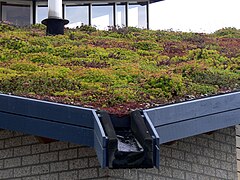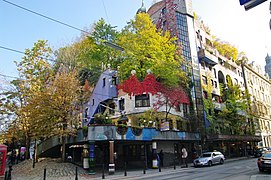Sponge City
Sponge town or Sponge-City is a concept of urban planning to take, accumulating rainwater locally in cities and to store rather than channel it only and derive. This is intended to prevent flooding during heavy rain events, improve the urban climate and promote the health of urban trees .
concept
Due to the high degree of surface sealing in modern cities , most of the rainwater is discharged via the sewer system . In the event of heavy rain, therefore, large amounts of runoff have to be transported; if the sewer system is overloaded, urban flash floods can sometimes occur. Urban heat islands emerge in the warm season . In the case of prolonged drought, the sealed surfaces, concrete, steel and glass facades additionally heat the city without evaporating water being able to provide cooling.
With the Sponge City concept, rainwater is to be temporarily stored where it falls. Environmental- technical and landscape-architectural infrastructure for this are, for example, infiltrable traffic areas and pavements , hollows , trenches , urban green spaces and wetlands . Elements of green infrastructure such as trees, green facades and green roofs allow part of the water to evaporate and thus help cool the city. Another part can seep away . Thus the sewer network is relieved.
Trees can make a big contribution to improving the urban climate by providing shade and providing large areas of evaporation. Water that they take up from the soil evaporates through their leaves, and the resulting evaporative cooling improves the local microclimate. In order for trees to develop a large crown, they need a lot of space for their roots. In order to be able to temporarily store water in the ground and to provide enough space for root growth, the soil must be loosened instead of compacted . At the same time, the floor must also offer sufficient stability for streets and sidewalks. This can be achieved by a mixture of chippings , compost and other water-storing fine materials.
Image examples
implementation
After the devastating floods in Beijing in 2012, the People's Republic of China paid more attention to flood protection . In 2015 an initiative was started to design 16 cities as showcase projects based on the concept of the sponge city. The initiative was later expanded to include 30 cities. 70 percent of the rainwater should be collected there, reused or absorbed by the subsoil. The restoration and renaturation of natural watercourses should also protect against flooding.
In the Seestadt Aspern in Vienna , the principle of the sponge city is to be implemented in some streets. Another example is the Hamburg green roof strategy .
literature
- Chris Zevenbergen, Dafang Fu, Assela Pathirana (Eds.): Sponge Cities: Emerging Approaches, Challenges and Opportunities. MDPI, Basel 2018, ISBN 978-3-03897-272-3 , doi : 10.3390 / books978-3-03897-273-0 (English).
supporting documents
- ↑ a b The concept of Sponge-city. In: sieker.de . Retrieved August 25, 2019.
- ↑ a b Elke Ziegler: The Sponge City lets trees grow. In: orf.at . March 16, 2019, accessed August 25, 2019.
- ↑ a b "Sponge City" makes trees fit for climate change. In: wien.gv.at . Retrieved August 25, 2019.
- ^ Helen Roxburgh: China's 'sponge cities' are turning streets green to combat flooding. In: theguardian.com . December 28, 2017, accessed August 25, 2019
- ↑ Jörg Römer: How cities defy water masses and drought. In: spiegel.de . September 24, 2018, accessed September 13, 2019.






